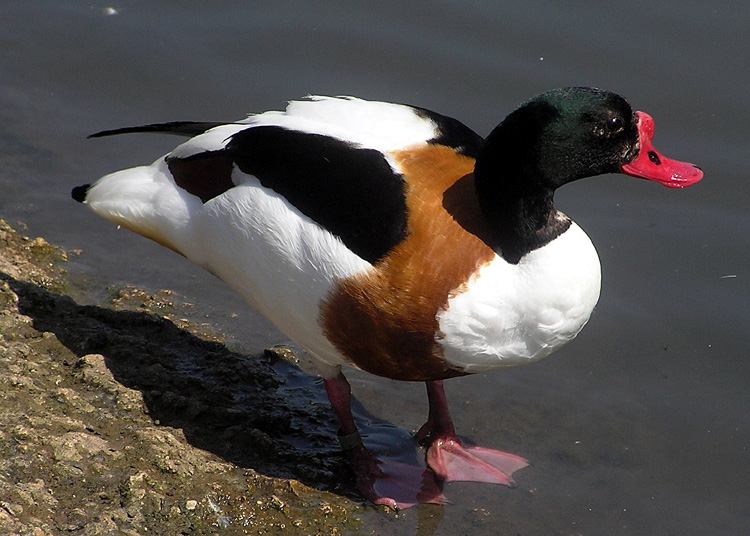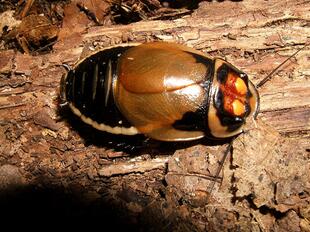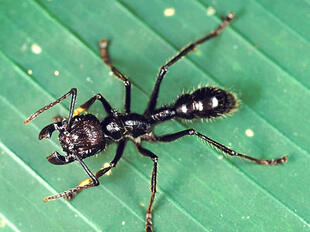
Common shelduck(Tadorna tadorna)
Phylum —chordata
Class — aves
Order — anseriformes
Family — anatidae
Genus –tadorna
Appearance
The common shelduck resembles a small short-necked goose in size and shape. It is a striking bird, with a reddish-pink bill, pink feet, a white body with chestnut patches and a black belly, and a dark green head and neck. The wing coverts are white, the primary remiges black, and the secondaries green (only showing in flight) and chestnut. The underwings are almost entirely white. Sexes are similar, but the female is smaller, with some white facial markings, while the male is particularly crisply colored in the breeding season, his bill bright red and bearing a prominent knob at the forehead.
Length – 61-63 cm, weight – 800-1450 g.
Habitat
This is a bird which breeds in temperate Eurosiberia. Most populations migrate to subtropical areas in winter, but this species is largely resident in westernmost Europe, apart from movements to favored moulting grounds, such as the Wadden Sea on the north German coast.
The common shelduck is common around the coastline of Great Britain and Ireland (where it is simply known as shelduck), where it frequents salt marshes and estuaries. It frequently nests in rabbit burrows. Sightings of this bird are rare in North America and are reported as infrequent visitors to the U.S. and Canada.
Behavior
Moulting flocks can be very large (100,000 on the Wadden Sea), since most pairs leave their partially grown young in a crèche with just one or two adults.
These ducks are powerful fliers and they perform fast wingbeats. On land, they walk quickly thanks to their fairly long legs.
Diet
The common shelduck feeds on aquatic invertebrates such as mollusks, insects and crustaceans.
Reproduction
The common shelducks´ pair forms in autumn or early winter, but most of them can form mainly in January/February, when the males start to display.But most pairs persist from year to year. They move to their territorial feeding areas by late March. They regularly visit potential nest-sites and usually, several nests can be close together with no territory around the nest-site.
The breeding season starts in April/June. They nest in cavities in hollow trees or in burrows dug by rabbits. The nest is made with grass and moss, and is lined with down.
The female lays 8-10 creamy-white eggs. The incubation lasts 29-31 days by the female alone, while the male remains in the close vicinity of the nest.
The chicks leave the nest very soon after hatching, and sometime have to walk some distance to reach the water. Both parents lead them to the feeding areas and defend them against predators.
The chicks of a colony often form crèches where some adults guard them. They fledge about 45-50 days after hatching, and are independent as soon as they can fly.
Incaptivity
Lifespan -up to 20 years.
Shelducks are large enough with bright color.It is easy to take care of them. They are perfectly adapting to life in aviaries, grow well and regularly give healthy offspring, which are selflessly taken care of by both parents. The main difficulty faced by beginners in breeding of these birds is their excessive aggressiveness during the breeding season, intolerance of the presence of birds of any kind in the breeding territory. A male guarding a clutch of a female or brood can pounce on both a large bird of prey and a predatory mammal and a human.
At the same time, a couple with their own brood often takes other birds` chicks under their protection, and sometimes even takes them away from their parents. Young birds under 2 years of age who have not reached sexual maturity are more tolerant to life in a large flock. Adult birds get along peacefully with other representatives of waterfowl during the molting period at the end of the nesting period. But, in addition to seasonally aggressiveness when the male defending its territory can kill smaller ducks and even geese, we need to understand that bird keeping in mixed flocks can be the reason for hybridization with any of the members of the genus Tadorna, as well as geese, breasted geese and domestic ducks.
Large aviaries as a place for seasonal keeping of a small group of adult immature or molting birds should be much more spacious than for any other waterfowl. The minimum size of the enclosure for a pair of shelduckscannot be less than 100 square meters. For good growth, regular reproduction and preservation of the brood population, it is necessary to provide the shelducks with the opportunity to graze on a large area with low grass. It is recommended to equip a large, shallow pond.
Despite the fact that the Eurasian species of genus Tadorna easily survive at low temperatures, they still need dry enclosed spaces for a long frosty period. If birds are outsideduring the cold weather for a long period of time they have frostbite of the paws.
In captivity, it is important for shelducks to have a possibility of grazing on grass. The natural herbal diet is supplemented with special compound feeds and bread. In winter, the grain diet consists of wheat, oats, lentils, peas, crushed corn is supplemented with finely chopped peelings of vegetables such as potatoes, carrots, cabbage and others.
Hatched ducklings are fed with industrial starter feed. Duckweed, a lot of chopped greens − lettuce and spinach, insects and earthworms are useful for the growth of chicks. Providing access to low-grass pasture from an early age guarantees the brood rapid growth and maximum survival. A shallow container with clean drinking water, which is replaced as it becomes contaminated, but at least once or twice a day, should always be in the place of feeding the bird.
 Russian
Russian
 English
English
























